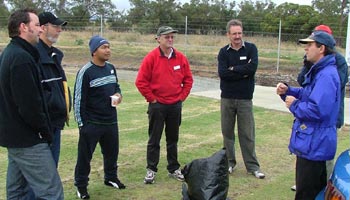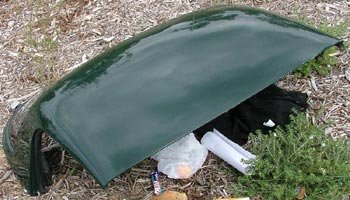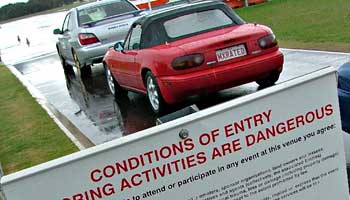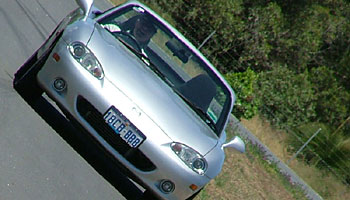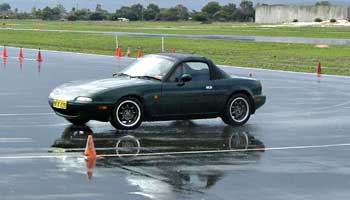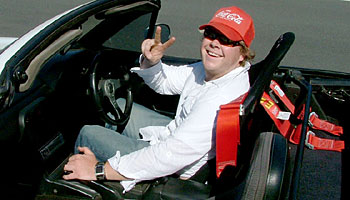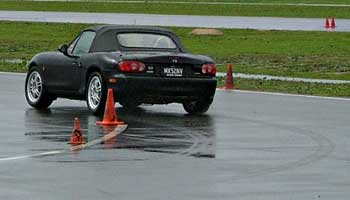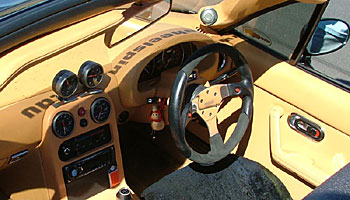DRIVER PROFICIENCY
Life member Ian Lewis's collection of Driver Proficiency Tips
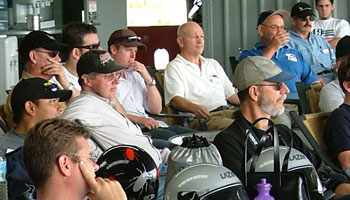
Expert Techniques for Autokhanas
Highlights from Henry Watts' Secrets of Solo Racing (17/08/05)
Autokharna Introduction
A safe way to learn how to drive your car at the limits of it's potential.
- How to drive an autokhana
- Read the latest supplementary regulations.
- Memorise the next test.
- If possible, walk the course.
- Watch the other drivers.
- Once in your car, close your eyes and run the course in your mind.
- On the start line, take a deep breath and get focussed.
- Ask for feedback from other drivers.
Driving Basics
- Concentration is your most important skill.
- By making gradual and deliberate changes, you will steadily approach the maximum potential of you and your car.
- Hand position should be quarter to three. Push-pull is too slow for competition.
- Never, ever, grab the wheel from the inside.
- 25cm away from a cone is 20cm too far away.
- When throttle is called for, use all of it.
- When not using the throttle, use the brakes. Don't coast.
- Do not lock the brakes.
- Slip angle is the difference between the direction the tyre is facing and where it's heading. High slip angles slow the car down.
- Road car suspension is set to understeer, because it's safer, but understeer is pronounced at slow speeds so get it dialled out. Expect increased oversteer at mid to high speeds. It will not be a problem if you don't do anything to make it worse.
- Induced oversteer can be used to help you turn the car without slowing down. Throttle lift; trail brake or power (hard to master, but best on slow corners).
Starts
- You will enter the track as soon as the previous competitor has completed the course and has exited. This is the time to alternate hard acceleration and hard braking to warm the tyres. Approach the start box, stopping when you see the staging lights at the far end of the box. Black lines (rubber) on the surface increase traction, so use them (except in the wet). Once both competitors have staged the lights will turn green and you may start when you're ready.
- Hold your desired launch RPM (4-5000 rpm) steady before you let out the clutch and floor the throttle.
- Your car will accelerate fastest (in a straight line) with 10% slip - a little wheel spin is good!
Braking, Turning & Shifting
- Expect the track to be slippery first thing.
- If you must err, brake too early rather than too late (especially at the finish where braking too early may cost you 2 tenths. Too late costs 3 seconds)!
- Downshift (heel & toe) as late as you can.
- Use the entire width of the course. A wide entrance means almost touching the cone!
- Begin the turn before you have completely released the brakes, to keep the outside front corner loaded, minimising understeer.
- To correct understeer, lift the throttle and reduce the lock a little. If needed apply the brakes a little.
- In choosing your line, always think about the course before and after the turn.
- If you get on the throttle earlier and apex late, you will come out of the turn faster and cover every metre of the following straight at a higher speed.
- When approaching two turns linked by a very short straight, it's the line through the second that's most important.
- In a decreasing radius turn the basic technique is to come in fairly fast, throttle lift and gently brake half way round, to induce a little oversteer and accelerate just before the very late apex.
- Turns that precede a long straight must have a late apex to get the fastest exit speed.
- In tight turns that precede a very short straight you're better off hugging the inside edge - it's a shorter distance and you don't need exit speed.
- Hit your apexes. It can take two more turns to recover your line!
- Throttle-induced oversteer can tear up your tyres and will slow you down.
- The most common mistake in slaloms is to spin due to throttle lift as you turn. If you have to lift, do it on the straight, but apply a little throttle as you turn to keep the weight on the back tyres.
- Avoid up-shifting in a turn
Optimising Your Approach to the Complete Course
- To analyse a complete course, start by looking for the longest straights and make them longer!
- The most important turns precede the longest straights. Use a wide entrance, accelerate through a late apex and get a fast exit.
- If the straight after the turn is short, brake later, apex earlier, go deep.
- If you're only a second from braking, it's better to bounce on the rev limiter than waste time changing up and back down again.
- When things get very slow and tight, take the shortest route.
- Focus on the next apex. Look ahead.
Preparing Your Car
- Less weight means quicker acceleration, cornering and stopping. Remove everything that you don't need for the competition. Recent rule changes have stopped us from removing the passenger seat, but spare tyre, jack & tools should be removed.
- Arrive at the track with < ¼ of a tank of fuel and a spare 5 litres. A full tank adds 40kgs and can slow you down by as much as one second.
- Many seconds can be trimmed off your time by careful suspension adjustment. Wheels World are MX-5 experts!
- Be sure that your suspension tuning is done with something, or someone as heavy as you in the driver's seat.
- Autokhana cars should be set up to be neutral at low speed & tend towards oversteer at medium speeds. You can't accelerate through understeer!
- Soften the sway bar on the end that is not sticking. If the front bar is not adjustable, stiffening the rear bar will help reduce understeer.
- Lowering the suspension reduces body roll and the need for negative camber and therefore unwanted inside tread wear during road use.
- A spinning wheel wastes power and wears your tyre out. A limited slip diff will help you get the power down (but increase power oversteer).
- A multi-point harness will help hold you into the seat, so that you can better feel the steering. A race seat will help even more.
Tyres
- Most tyres are past their use-by date before the tread is gone, but may be revived by shaving.
- R Compound tyres have softer rubber, larger tread blocks and less depth to reduce squirm and increase grip. If you can afford it, have your tyres shaved down to 2.5mm for important competitions.
- Some new tyres need a few runs (heat cycles) to give optimum grip. (They often have a "protective" coating applied during manufacturing, this is very greasy. Always drive with extreme caution within the first 500km or so on a new set of tyres)
- It used to be popular to run high tyre pressures. Pyrometer work has shown that it is better (especially if you're running R compound tyres) to run low pressures. Manufacturers recommendations are often correct!
- Up to a point, lower pressures will increase the grip, but the car will feel mushier, less precise.
- Use the entire width of the tyre. Lower the pressure until they wear to the edge of the tread.
- Once you've found the ideal (hot) tyre pressure, stick to it.
- The only important tyre pressure is the operating pressure on the course. Check your pressures as soon as you arrive at the track and reset them immediately after each run.
- Camber settings can be confirmed by measuring the tread depths across the tyre.
- Pyrometers are the best method to set tyre pressure, sway bars and camber (Fr & Rr tyres should be the same temperature), but you need an assistant. If you wait til you've parked and got out of the car it's too late!
- And a final thought on understeer - if you're at the track and the car is continually understeering and it's not just because you're entering the corners too fast, reduce the front tyre pressure a couple of pounds. After the event get the suspension adjusted (usually more neg camber and toe-in) and go back to even front and rear pressures.
Accelerating
- Starts - Hold your desired launch RPM (4-5000 rpm) steady before you let out the clutch and floor the throttle.
- The ideal clutch release takes one second from when it starts to bite to foot off the pedal.
- Your car will accelerate fastest (in a straight line) with 10% slip - a little wheel spin is good!
- For maximum acceleration you must reach the red line before changing gear.
- It might sound obvious, but to go fast it's best not to spend too long on the brakes.
- At the end of straights the transition should be from full throttle to maximum braking. Never coast.
- Make long straights longer by accelerating early and braking late.
- By making gradual and deliberate changes, you will steadily approach the
maximum potential of you and your car.
Throttle Control
- When throttle is called for, use all of it.
- To correct understeer, lift the throttle.
- Induced oversteer can be used to help you turn the car without slowing down (tight turns only!). Turn in, apply full throttle and get ready to apply opposite lock as you exit the turn.
- Throttle-induced oversteer (on fast corners) can tear up your tyres and slow you down.
- The most common mistake in slaloms is to spin due to throttle lift as you turn. If you have to lift do it on the straight, but apply a little throttle immediately after turn-in to put some weight on the back tyres.
- Rubber on the surface increases traction. Look for it on the start line.
- By making gradual and deliberate changes, you will steadily approach the maximum potential of you and your car.
Clutch Technique
Release the clutch pedal too slowly and you risk overheating the friction plate. When it gets too hot it loses grip and gets even hotter, eventually resulting in a permanently slipping clutch. You can tell a driver who releases too slowly by the telltale burning clutch smell they leave behind! Release the clutch too quickly and you risk stalling, spinning the rear wheels, running into the car in front, breaking the diff or just giving your passenger a headache. The ideal clutch release takes one second from when it starts to bite to foot off the pedal.
Gear Change
- Change up @ the red line, unless you're almost at the end of the straight, in which case hold it on the rev limiter. It won't hurt a bit!
- Change down (heel & toe) just before you turn in.
- Hold the gear stick with your finger and thumb, not your fist.
Into 1st - Hold the knob in the vee of your thumb and first finger and push left and forward.
Into 2nd - Place your fingers on top of the gear knob, rotate your wrist (thumb down), hook your fingers and pull back.
Into 3rd - Hold the knob in the vee of your thumb and first finger. Push forward, relaxing in neutral to let the spring take it into the centre line and push forward again.
Into 4th - Place your fingers on top of the knob, hook your fingers and pull back, relaxing in neutral to let the spring take it into the centre line, then pull back again.
Into 5th - Hold the knob in the vee and push forward and to the right.
Into 6th - Lucky you! Place your fingers on top of the gear knob, rotate your wrist (thumb up), hook your fingers and pull back.
Note: - Feel free to miss out gears on the way down. Eg 5th to 3rd or 2nd. - When you're not gear changing put your hand back on the wheel.
- By making gradual and deliberate changes, you will steadily approach the maximum potential of you and your car.
- Heel & Toe - To change down a gear without causing the engine
to brake the driving wheels, reducing their grip on the road.
Technique - Brake with the ball of your right foot in the centre of the brake pedal. Just before you turn into the corner, depress the clutch, roll your right foot so that the right side of your shoe 'blips' the throttle, raising the revs. Before the revs drop down again, change down a gear (or two) and let out the clutch.
Braking
- It might sound obvious, but to go fast it's best not to spend too long on the brakes.
- At the end of straights the transition should be from full throttle to maximum braking. Never coast.
- Always brake hard, but don't lock the brakes. ABS? Stand on the pedal!
- Make long straights longer by accelerating early and braking late.
- If the straight before the turn is long enough and the straight after the turn is relatively short, you should aim for an early apex, allowing you to brake later.
- It's safer to brake too early rather than too late.
- Turn-ins are sharper if you begin the turn before you have completely released the brakes.
- In a decreasing radius turn, come in fairly fast, throttle lift and gently brake half way round to induce a little oversteer and accelerate just before the very late apex.
- By making gradual and deliberate changes, you will steadily approach the maximum potential of you and your car.
Steering
- Both hands on the wheel. Quarter to three.
- Never grab the wheel from the inside.
- In choosing your line, always think about the course before and after the turn.
- Use the entire width of the course - every millimetre!
- Begin the turn before you have completely released the brakes, to keep the outside front tyre constantly loaded.
- In tight turns that precede a very short straight you're better off hugging the inside edge - it's a shorter distance and you don't need exit speed.
- When approaching two turns linked by a very short straight, it's the line through the second turn that's most important.
- Apex: n., the point at which you come the closest to the inside of the turn.
- Hit your apexes. 25cm away from the cone is 20cm too far away!
- Even if you are sure the car will not go to the apex, turn in and hit the apex!
- A late apex is the safest way to approach a high-speed turn.
- When things get very slow and tight, do not try for super late apexes.
- The most important turns precede the longest straights. Use a slow entrance, late apex and fast exit.
- Turns that precede a long straight must have a late apex to get the fastest exit speed.
- If you come out of the turn faster you will cover every metre of the following straight at a higher speed.
- In a decreasing radius turn the basic technique is to come in fairly fast, throttle lift and gently brake half way round, to induce a little oversteer and accelerate just before the very late apex.
- Neutral handling cars (MX-5s) tend to understeer at slow speeds and oversteer at high speeds.
- Slip angle is the difference between the direction the tyre is pointing and where it's travelling. High slip angles (over & understeer) slow the car down.
- Understeer: n., when the car continues to travel relatively straight ahead despite the front wheels being turned, due to lack of traction.
- To correct understeer, lift the throttle and reduce the lock. If needed apply a little brake.
- Oversteer: n., when the car is turning tighter than the angle of the front wheels, due to lack of traction causing the rear tyres to slide outwards.
- A small amount of oversteer will not be a problem if you don't do anything to make it worse.
- Induced oversteer can be used to help you turn the car without slowing down. Throttle lift; trail brake, hand-brake or power (hard to master, but best on slow corners).
- Throttle-induced oversteer can tear up your tyres and will slow you down.
- Quick Slaloms
- Maintain an even throttle from the beginning to the end of the slalom. Make smooth direction changes. Make late apexes.
- Quicker Slaloms
- Approach each turn-in point in a straight line (in competition 5,500-7,000rpm), throttle lift (and brake if necessary) to transfer some weight onto the front tyres. This will give the front end a bit more grip and enable the car to turn in sharper. Once you've started the turn you should apply some throttle to transfer weight to the back tyres and counteract the tendency for oversteer. Once you're aiming at the next turn-in point you can apply full throttle. The more times you change direction the more the pendulum effect will reduce the grip of the tyres, so aim to enter the slalom as fast as you can and if necessary take subsequent turns slightly slower. Never brake when the steering wheel is turned.
- By making gradual and deliberate changes, you will steadily approach the
maximum potential of you and your car.
Steering Technique by Ralph Schumacher
You can recognize an experienced helmsperson by the way they hold the steering wheel. I'd advise any driver to adopt the 9 o'clock - 3 o'clock hand position. In the racing car I need my thumbs for the steering wheel switches, while in an ordinary car I generally rest them on the spokes: the position becomes normal. With their hands in this position drivers always know which way the front wheels are pointing, even if they skid on sand or water. Most accidents caused by skidding happen precisely because the front wheels aren't pointing in the direction of motion. As soon as the tyres start to grip after sliding, the car shoots forward in the direction the wheels are pointing. If they're pointing at a tree or kerb, that's where the car ends up.
If you've got both hands in the correct position, you can get around virtually any curve and you're easily able to take avoidance action by feel at any speed. The pseudo-cool driver doesn't have the feel. Drivers who know what they're doing don't drive along the roads with one hand or both hands at the top or bottom of the steering wheel; they don't drive as though they're washing dishes (palm of the hand on the rim) and they don't pretend they're milking a cow (hand on the inside). Your hands only leave the optimum position if you're taking a very tight corner, turning off, or parking. You only have to change the position of your hands in order to turn the wheel more than 180°.
There's a good technique for changing the position of your hands. You should steer into a curve with the hand on the outside of the curve (left hand in right hand corner) pushing the steering wheel, rather than the inside hand pulling it. This presses the upper body and shoulders into the seat. The connection with the vehicle (feel) increases and steering becomes more effective - particularly in fast cornering. When the hand on the inside of the curve reaches your thigh, you take it off the wheel. The hand on the outside of the curve continues to push the wheel round. Meanwhile the inside hand moves to the opposite side, grips the rim and pulls the wheel further round. The hand on the outside then grips the wheel in the original position and continues to push the wheel round to complete a full circle. If the wheel hasn't turned enough, the driver needs repeat the technique.
Believe me, this technique has been well proven in everyday driving and racing. It takes a while to get used to, particularly if you've been washing plates or milking cows. I can recommend practicing the technique on hairpin bends and in driver training courses.
LATEST NEWS
- 18/02New Life Member - Don Messenger
- 05/04CANCELLED S12R2 this Sunday 10/04/22 CANCELLED
- 05/032022 Motorsport ENTRIES NOW OPEN
- 27/01Proof of vaccination
PAST EVENTS
- 18/04Monthly Committee Meeting
- 17/04After Work Get Together - Varsity Bar
- 14/04Mandurah to The Jarrahdale Tavern
- 07/04Monthly Cruise - Williams Campdraft
COMING EVENTS
- 27/04Saturday Cruise - Sunset at the Beach
- 05/05Monthly Cruise - The Rec Hotel, Waroona
- 05/05Southern MX-5
Combined Run to the Rec Hotel in Waroona - 19/05Dawn BreakFast Raid - British Car Day - Gingin
- 22/05Midweek Lunchtime Cruise - Stringybark Winery
- 23/05Monthly Committee Meeting
- 02/06Monthly Cruise - Julimar Jaunt
- 20/06Midweek Lunchtime Cruise - Mystery Location
- 27/06Monthly Committee Meeting
- 07/07Christmas in July - Chidlow Tavern
- 20/07Saturday Cruise - Cherith Grove Cafe
- 25/07Monthly Committee Meeting
- 04/08Monthly Cruise - 3 Towns & a Tavern
- 17/08Saturday Cruise - Spencers Brook Tavern
- 22/08Committee Meeting & AGM
- 27/08After Work Get Together - Parmagaddon @ The Lookout
- 01/09Monthly Cruise - Journey to Jarrahdale
- 18/102024 Road Trip - Tall Trees Tour
- 01/12 Santa’s Sleigh Ride to Noble Falls Tavern
